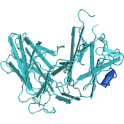
- Remove this product from my favorite's list.
- Add this product to my list of favorites.
Products
Newsletter
 |  |  |  |  |  |

The Eph receptors are part of the receptor tyrosine kinases and can be divided into two classes, EphA and EphB, which respectively bind the glycosylphosphatidylinositol-linked ephrin-A ligands and the transmembrane ephrin-B ligands. Eph receptors and ephrin ligands interact through cell/cell contact because they are bound to the plasma membrane. Thus, they activate bidirectional intracellular signaling emanating from both the receptor (forward signaling) and the ligand (reverse signaling). Upon ephrin binding, the Eph receptors are phosphorylated at specific tyrosine residues in the cytoplasmic region, serving as docking sites for various signaling molecules like Src, Grb2 and PI3K. Eph receptor signaling pathways target e.g. Rho GTPases, leading to the reorganization of the actin cytoskeleton and furthermore Eph receptors and ephrins can promote angiogenesis through their effects on endothelial cell migration as well as proliferation. The EphB4 receptor tyrosine kinase is expressed in the epithelial cells of human breast tissue. Regulated expression of EphB4 and its preferred ligand ephrin-B2 is important for mammary gland morphogenesis.
Protein: human EPHB4 (amino acids L563-Y987 as in GenBank entry NM_004444.2), N-terminally fused to GST-HIS6-Thrombin cleavage site
Theoretical MW : 76.8 kDa (fusion proteins)
Expression system: Sf9 cells
Specific activity : 78,000 pmol/mg x min
Method for determination of Km value & specific activity: Filter binding assay MAFC membrane
Protein concentration: 0.235mg/ml (Bradford method using BSA as standard protein)
Entrez Gene ID: 2050
UniProtKB: P54760
ordering information: shipped on dry ice
Schmucker D, Zipursky SL (2001) "Signaling downstream of Eph receptors and ephrin ligands.” Cell 15;105(6):701-4.
Noren NK, Pasquale EB (2007) “Paradoxes of the EphB4 receptor in cancer.” Cancer Res. 1;67(9):3994-7.
Nakamoto M, Bergemann AD (2002) "Diverse roles for the Eph family of receptor tyrosine kinases in carcinogenesis.” Microsc Res Tech. 1;59(1):58-67.
Welcome Login
Contact us
Follow us